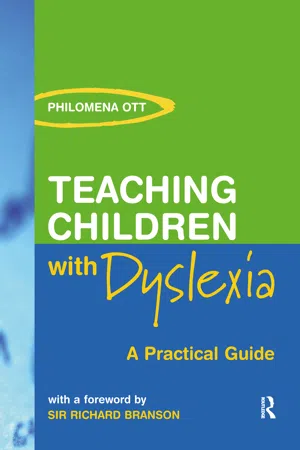
- 320 pages
- English
- ePUB (mobile friendly)
- Available on iOS & Android
About this book
Teaching Children with Dyslexia is essential reading for any teacher, Special Educational Needs Co-ordinator or teaching assistant who wants an insider's account of what dealing successfully with dyslexia entails.
Written by one of the most well-regarded practitioners in the field with over twenty-five years' experience, this book is packed full with photocopiable exercises, activities and recommendations for resources, tests, teaching methods, advice and suggestions for strategies and techniques that are instantly transferable to classroom environments. This essential teaching companion includes chapters on:
- how to spot dyslexia
- screening and assessment tests
- why it does not have to be hell to learn to spell
- strategies for success for reluctant writers
- meeting the challenge of dyslexia in adolescence.
Written specifically to bolster teachers' confidence and empower them with the key to unlocking literacy problems in their most challenging pupils, this resource book should be on the shelf of every staff room.
Frequently asked questions
- Essential is ideal for learners and professionals who enjoy exploring a wide range of subjects. Access the Essential Library with 800,000+ trusted titles and best-sellers across business, personal growth, and the humanities. Includes unlimited reading time and Standard Read Aloud voice.
- Complete: Perfect for advanced learners and researchers needing full, unrestricted access. Unlock 1.4M+ books across hundreds of subjects, including academic and specialized titles. The Complete Plan also includes advanced features like Premium Read Aloud and Research Assistant.
Please note we cannot support devices running on iOS 13 and Android 7 or earlier. Learn more about using the app.
Information
Chapter 1
The really useful guide for parents, carers, teachers and professionals dealing with dyslexia and dyspraxia at home and in pre-school settings
| Outline • What is dyslexia? • What are the early warning signs of SEN? Guidelines for concerned parents and carers • Who’s who of educational and healthcare professionals • What is the significance of early intervention for those with SpLD? • Extrinsic factors that may affect language acquisition • Checklist to help identify children at risk of dyslexia/dyspraxia • What speaking and listening skills do children need to function effectively? • Speech and language disorders indicative of SEN with suggestions to help compensate and overcome them. • Activities to help with sequencing and with fine and gross motor difficulties • What is dyspraxia (DCD)? • Indications of dyspraxia with suggestions to help • Difficulties associated with laterality, directionality and time; suggestions to help compensate and overcome them • Terms and conditions to include in a happy family’s ‘homework treaty’ • Websites for pre-school activities, homework and revision • Checklist for resources and a shopping list for dyslexic and dyspraxic pupils • Hints on why and how to use ICT resources • Summary and conclusions |
What is dyslexia?
Table of contents
- Related titles from Routledge:
- Contents
- Foreword by Sir Richard Branson
- Preface
- Acknowledgements
- Abbreviations
- Chapter 1 The really useful guide for parents, carers, teachers and professionals dealing with dyslexia and dyspraxia at home and in pre-school settings
- Chapter 2 Why good home–school partnerships promote better relationships and further understanding of special educational needs
- Chapter 3 Dealing with dyslexia and dyspraxia at home and in dyslexia-friendly schools and classrooms
- Chapter 4 Why does learning to read require explicit teaching?
- Chapter 5 The theory and processes involved in teaching reading: suggestions for closing the gaps in reading attainments
- Chapter 6 Why spelling is often a major stumbling block for dyslexic children and what to do about it
- Chapter 7 Strategies for success for writers: tricks of the trade and hints galore to lighten the load for dyslexic and dyspraxic writers
- Glossary
- Bibliography
- Index